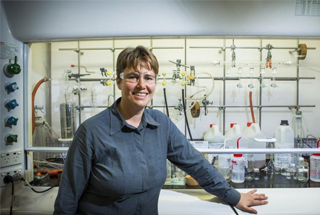Supercharging efficiency

As the push to increase renewable energy sources intensifies, ANU researchers are at the forefront of new innovations, as TEGAN KAHN, BMedSc (Hons) '09, reports.
Solar panels adorn the rooftops of more than one million Australian homes and the industry is booming. Yet most commercial solar cells are often relatively inefficient.
Many solar panels only convert up to 15 per cent of the sunlight received into electricity but ANU scientists are working on improving this rate.
Research by Professor Michelle Coote and a team of eight scientists from the ANU Research School of Chemistry has led to the doubling of the efficiency of solar cells using the National Computational Infrastructure (NCI) at ANU.
Next-generation dye-sensitised solar cells are more efficient than current commercial solar cells and work in lower light conditions.
They are predicted to revolutionise solar power generation in the next decade.
But, as with any new technology, it's not perfect yet, as Coote and her team found out.
In a dye-sensitised solar cell, the dye absorbs sunlight, causing the dye to change form and release an electron. This generates electricity.
A second component is then needed to convert the dye back to its starting form so the process can begin again. This component is called a redox mediator.
"Most dye-sensitised solar cells use an iodide molecule as the redox mediator," Coote explains.
"This has a number of disadvantages. Firstly, it is coloured and that cuts down on how much sunlight is available to be absorbed by the dye.
"Secondly, its oxidation potential [its ability to give electrons back to the dye and thus convert it back to its starting form] is not very well matched to the dye, leading to inefficiency."
For several years, researchers across the world had proposed the use of a nitroxide radical as the redox mediator instead.
"Nitroxide radicals are colourless and their oxidation potential is much closer to the range needed to get maximum efficiency in the conversion of the dye," Coote, who is part of the ARC Centre of Excellence for Electromaterials Science, says.
The problem was the researchers who set out to test nitroxide used a molecule that undergoes a number of rearrangements on oxidation.
"That means it's sort of being destroyed in the first round of electron transfer, so it's not around to keep cycling," Coote says.
The ANU team saw these results and decided to use computational chemistry to investigate why this particular nitroxide molecule was unstable upon oxidation.
They also looked at what structural changes could be made to stabilise it while keeping its oxidation potential within the ideal range for the dye.
"We used Raijin [the supercomputer at NCI] to investigate many different structures and came up with five predicted compounds that we thought would work," Coote says.
"Not long afterward, an independent experimental research group in Japan manufactured a solar cell using one of our compounds.
"The new compound doubled the efficiency of the solar cell."
Coote says using computational quantum chemistry is crucial to her research and provides a much deeper insight into chemical processes than can be provided by experiment.
"We absolutely could not do this work without access to Raijin," she says.
